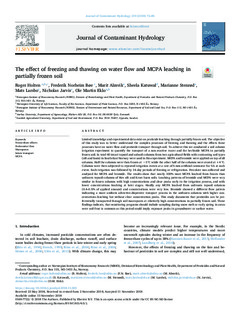| dc.contributor.author | Holten, Roger | |
| dc.contributor.author | Bøe, Frederik | |
| dc.contributor.author | Almvik, Marit | |
| dc.contributor.author | Katuwal, Sheela | |
| dc.contributor.author | Stenrød, Marianne | |
| dc.contributor.author | Larsbo, Mats | |
| dc.contributor.author | Jarvis, Nicholas | |
| dc.contributor.author | Eklo, Ole Martin | |
| dc.coverage.spatial | Norway | nb_NO |
| dc.date.accessioned | 2018-12-06T12:04:21Z | |
| dc.date.available | 2018-12-06T12:04:21Z | |
| dc.date.created | 2018-11-23T19:31:46Z | |
| dc.date.issued | 2018-11-13 | |
| dc.identifier.citation | Journal of Contaminant Hydrology. 2018, 219 72-85. | nb_NO |
| dc.identifier.issn | 0169-7722 | |
| dc.identifier.uri | http://hdl.handle.net/11250/2576392 | |
| dc.description.abstract | Limited knowledge and experimental data exist on pesticide leaching through partially frozen soil. The objective of this study was to better understand the complex processes of freezing and thawing and the effects these processes have on water flow and pesticide transport through soil. To achieve this we conducted a soil column irrigation experiment to quantify the transport of a non-reactive tracer and the herbicide MCPA in partially frozen soil. In total 40 intact topsoil and subsoil columns from two agricultural fields with contrasting soil types (silt and loam) in South-East Norway were used in this experiment. MCPA and bromide were applied on top of all columns. Half the columns were then frozen at −3 °C while the other half of the columns were stored at +4 °C. Columns were then subjected to repeated irrigation events at a rate of 5 mm artificial rainwater for 5 h at each event. Each irrigation was followed by 14-day periods of freezing or refrigeration. Percolate was collected and analysed for MCPA and bromide. The results show that nearly 100% more MCPA leached from frozen than unfrozen topsoil columns of Hov silt and Kroer loam soils. Leaching patterns of bromide and MCPA were very similar in frozen columns with high concentrations and clear peaks early in the irrigation process, and with lower concentrations leaching at later stages. Hardly any MCPA leached from unfrozen topsoil columns (0.4–0.5% of applied amount) and concentrations were very low. Bromide showed a different flow pattern indicating a more uniform advective-dispersive transport process in the unfrozen columns with higher con- centrations leaching but without clear concentration peaks. This study documents that pesticides can be pre- ferentially transported through soil macropores at relatively high concentrations in partially frozen soil. These findings indicate, that monitoring programs should include sampling during snow melt or early spring in areas were soil frost is common as this period could imply exposure peaks in groundwater or surface water. | nb_NO |
| dc.language.iso | eng | nb_NO |
| dc.rights | Navngivelse 4.0 Internasjonal | * |
| dc.rights.uri | http://creativecommons.org/licenses/by/4.0/deed.no | * |
| dc.subject | Freeze-thwa effects | nb_NO |
| dc.subject | Preferantial flow | nb_NO |
| dc.subject | Macropores | nb_NO |
| dc.subject | Solute transport | nb_NO |
| dc.subject | MCPA | nb_NO |
| dc.title | The effect of freezing and thawing on water flow and MCPA leaching in partially frozen soil | nb_NO |
| dc.type | Journal article | nb_NO |
| dc.type | Peer reviewed | nb_NO |
| dc.description.version | publishedVersion | nb_NO |
| dc.rights.holder | © 2018 The Authors. | nb_NO |
| dc.subject.nsi | VDP::Landbruks- og Fiskerifag: 900::Landbruksfag: 910 | nb_NO |
| dc.source.pagenumber | 72-85 | nb_NO |
| dc.source.volume | 219 | nb_NO |
| dc.source.journal | Journal of Contaminant Hydrology | nb_NO |
| dc.identifier.doi | 10.1016/j.jconhyd.2018.11.003 | |
| dc.identifier.cristin | 1634466 | |
| dc.relation.project | Norges forskningsråd: 244526 | nb_NO |
| cristin.ispublished | true | |
| cristin.fulltext | original | |
| cristin.qualitycode | 1 | |

